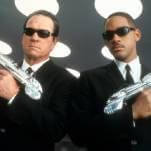Director André Øvredal on performing The Autopsy Of Jane Doe
Norwegian director André Øvredal’s new film, The Autopsy Of Jane Doe, couldn’t be more different from his international breakout hit, 2010’s Trollhunter. Where Trollhunter was a loosely shot found-footage fantasy, Jane Doe is a tightly controlled, stylized horror film where every element is meticulously calibrated to induce maximum terror in its audience. Brian Cox and Emile Hirsch star as a father-son coroner team who stay late one night in their family’s morgue to perform an autopsy on an unidentified woman they assume has been murdered. That may sound like the setup to some stomach-churning gore movie, but Jane Doe is far more clever than that. Instead, as the men perform the autopsy, Jane Doe’s body begins telling a terrifying story of who she was—and who she may still be.
The A.V. Club spoke with Øvredal the day after The Autopsy Of Jane Doe premiered at Fantastic Fest as he clutched a cup of coffee, perched on a vinyl booth in a private karaoke room.
The A.V. Club: At the Q&A yesterday, you said you wanted to do something different with this film. Did you feel like you wanted to prove something?
André Øvredal: I wanted to prove something because of Trollhunter[’s success]. It’s not a natural way for me to make films, trying to make found footage. It’s just a very specific style that you need to get into specifically for that project. But I grew up with filmmakers who are very controlled with storytelling, and that’s why I wanted to do something that was confined, and was just about the acting and the mood that I can create with the camera. And very simple, in a way.
AVC: It’s simple, but combines a bunch of different elements. Could you talk about building the morgue? You get some really rich colors in there.
AØ: I had a rule to not use white at all in the film, because I think white usually just looks dead, [although] it can be beautiful. But [the morgue] also had to have a feeling of history in the different design styles. That would mean browns, and bright colors, and generally giving it a feeling of having been there for decades, a hundred years or whatever. And we went through the script very carefully, and designed the set based on descriptions in the script and how they move around in the story. They move into the office, so the office has to be there. Then they go over to the elevator, so the elevator has to be down there. That’s how we sort of forensically figured it out. And then we built everything as one big piece so we could move around as we wanted. Also, basically we shot the whole film in continuity.
AVC: Oh really?
AØ: Yeah, because it’s so much… when you go back into a room, every little thing has moved just a little bit. Also [there are] all the physical effects of the body and how it evolves. So we had to do it in continuity. Otherwise it would have been an absolute mess.
AVC: That’s true. [Laughs.]








































